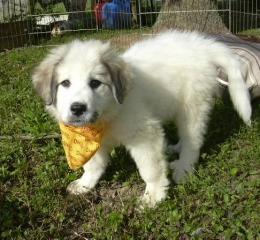I don't own a Pyr -- so I could be dead wrong -- but I've been stewing on something for a while now....
I'm really starting to think Pyrs are beginning to suffer the same fate as other "purebreds" these days....that is, being bred (and crossbred) indescriminately to the point of losing their working ability/classic characteristics.
Searches for Pyrs on craigslist over time have turned up a disheartening number of Pyrs labeled "Free, has killed ____________ [goats/chickens/ducks/etc]"..
I just saw an ad today for Pyrs that reads: "They are good with goats, sheep, cows, and horses. These particular pyrenees are not good with birds (chickens, ducks, turkeys, etc.)" -- which indicates to me that they've got more prey drive than they should.
Another ad has Pyr crossbreds for a mere $75/ea..
Another has pictures of "Pyrenees" puppies, but they're all white with black "mask" facial markings.... What's up with that?
Another ad reads: "I have 2 half great Pyrenees dogs for sale. One white female which is spaded and one red/white male" -- mean, "spaded?" Seriously? And, what's the other "half" made of? How do you even know it's half?
Another ad shows "Pyrenees" puppies...one's white with black spots, the other -- now, get this -- is tan with a black mask....$40/each.
The scary part is that these ads are from folks who know actually how to spell Pyrenees!!! God knows how many ads there are out there for "great perines" or "grate pirynees" pups on craigslist...
Yikes.




